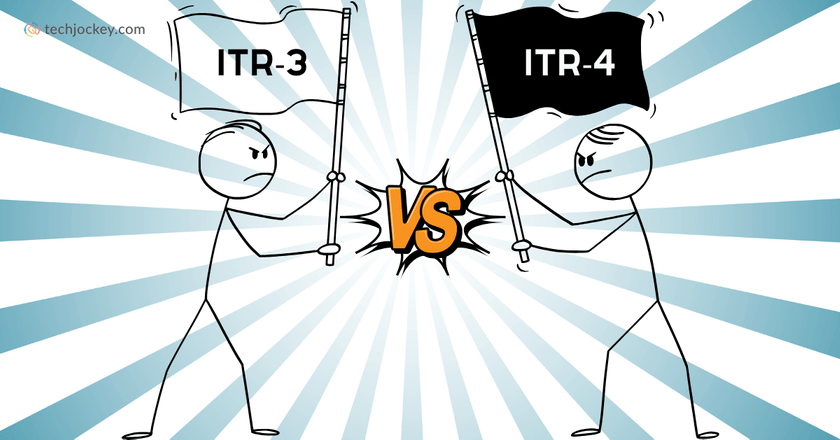Every year, over 80 million Indian taxpayers file income tax returns and breathe a sigh of relief as they finally click ‘file’. However, a large number of those signing up still find it hard to differentiate between the sundry ITR forms, especially ITR-3 and ITR-4.
This gives rise to the infamous ITR-3 vs ITR-4 debate, one that needs answering as quickly and effectively as is humanely possible. This, so you don’t end up selecting wrong forms, wasting your precious time and risking tax notices.
So, let’s understand the key differences between the two forms and end the discussion once and for all, shall we?
What are ITR-3 and ITR-4?
ITR-3 is designed for individuals and Hindu Undivided Families (HUFs) earning from business, profession, or as a partner in a firm, provided they have not opted for the presumptive taxation scheme under Sections 44AD, 44ADA, or 44AE.
It covers a range of individuals, including freelancers, consultants, multi-property owners, company directors and more. All in all, if your income sources are diverse and your business turnover crosses INR 2 crore, ITR-3 is your form.
Suggested Read: How to File ITR-3: A Complete Guide
ITR-4, also called Sugam, is tailored for resident individuals, HUFs, or firms (excluding LLPs) who opt for the presumptive taxation scheme. Under Section 44AD, 44ADA, or 44AE, income and expenses are declared at prescribed percentages, simplifying calculation and record-keeping.
The catch with filing ITR-4, however, is that your total income must not exceed INR 50 lakh, and property ownership is limited to one house.
Suggested Read: How to File ITR-4: A Complete Guide
ITR-3 vs ITR-4: Side by Side Differences
| Aspect | ITR-3 | ITR-4 |
|---|---|---|
| Type of Income | Salary, multiple house properties, capital gains, business/profession income, partnership income | Salary/pension (≤₹50L), single house property, business/profession under presumptive scheme |
| Eligible Taxpayers | Individuals & HUFs not under presumptive scheme, company directors, unlisted equity shareholders, requiring tax audit | Resident individuals, HUFs, partnership firms under presumptive scheme, small businesses/professionals |
| Accounting & Audit | Books of accounts mandatory above Section 44AA limits; tax audit if Section 44AB thresholds crossed | No books or audit required; income presumed under scheme |
| Deductions & Disclosures | Extensive deductions & allowances; detailed reporting of revenues, expenses, assets | Fixed deductions under presumptive scheme; less paperwork |
| Complexity | Detailed, multiple schedules, complex to file | Simple, fewer fields, easy to file |
| Business Size | Turnover >₹2 crore or professional receipts >₹75 lakh → mandatory | Smaller businesses/professionals within limits can opt |
ITR-3 vs ITR-4: key Differences
Type of Income
- ITR-3 covers diverse income streams, including profits and gains from business/profession, salary, multiple house properties, capital gains, and partnership income. If your income is varied or above INR 50 lakh, only ITR-3 form offers the flexibility needed.
- Form ITR-4, on the contrary, includes business/profession income under presumptive scheme for small businesses (turnover up to INR 2 crore) or professionals (receipts up to INR 75 lakh), salary/pension up to INR 50 lakh, and income from a single house property.
Eligible Taxpayers
- ITR-3 is to be filed by individuals and HUFs who have not opted for presumptive taxation. This includes company directors, people with stakes in unlisted equity shares, or those who need a tax audit.
- ITR-4, in contrast, is suitable for resident individuals, HUFs, and partnership firms operating on a small scale who prefer the presumptive system. As such, directors and those with more than one house property, unlisted equity investments, or deferred ESOP income aren’t eligible for ITR-4.
Accounting & Audit Requirements
- ITR-3 demands maintenance of detailed books of accounts if your income or turnover crosses limits specified under Section 44AA. Tax audit becomes mandatory if thresholds exceed Section 44AB’s limits.
- ITR-4, however, skips both books and audit. Your income is presumed, reducing paperwork and professional fees.

ClearTax Income Tax
Starting Price
Price on Request
Deductions & Disclosures
- ITR-3 offers extensive deductions, allowances, and disclosure options. Every revenue, expense, and asset must be reported in detail. If maximising deductions is a goal, this form gives control but requires conscious record-keeping.
- ITR-4, on the other hand, allows for fixed deductions built into the presumptive scheme. The trade-off: less paperwork but capped benefits.
Complexity
- Filing ITR-3 is like running a marathon, for the form is detailed, has numerous fields, schedules, and heads of income, all of which make it a complex form to fill out.
- ITR-4, conversely, feels like a walk in the park, because it has few fields to fill and is designed for clarity, for those eligible for the presumptive scheme.
Business Size
If your business turnover exceeds INR 2 crore, or if your professional receipts go above INR 75 lakh, ITR-3 is compulsory. Contrarily, smaller businesses and professionals, as long as their numbers don’t breach prescribed limits, can opt for ITR-4 for ease.
How to Decide Between ITR-3 and ITR-4? (In a Nutshell)
You should file ITR-3 if…
- You earn income from multiple house properties or investments in unlisted equity shares.
- You are a director in a company.
- Your business turnover or professional receipts exceed the thresholds for presumptive taxation.
- You seek to claim detailed expenses and deductions.
You should file ITR-4 if…
- You run a small shop, freelancing business, or a consultancy with manageable receipts.
- You don’t want the hassle of bookkeeping or audits.
- You’re comfortable with fixed percentage deductions and straightforward income calculation.
- Your total income, including salary, pension, and rental, is within INR 50 lakh.
ITR-3 vs ITR-4: Real World Examples
Understanding the difference between ITR-3 and ITR-4 becomes much easier when we look at real-world examples. Below are some practical case studies that show how different taxpayers should choose between the two forms…
- If you run a cloth retail shop with turnover under INR 2 crore, you can choose ITR-4 if you prefer the presumptive scheme, or ITR-3 if detailed accounting and deductions are needed.
- If you are an interior designer with receipts under INR 50 lakh, you should choose ITR-4 for simplicity.
- If you manage a wholesale business with turnover of INR 2.2 crore, you must file ITR-3 due to crossing the presumptive threshold.
- If you are an insurance agent, earning INR 18 lakh, you should file ITR-3, for insurance commission business cannot file ITR-4.
- If you are a heart specialist with annual receipts of INR 85 lakh, you can only file ITR-3 as your professional income exceeds the presumptive limit.
Conclusion
ITR-3 vs ITR-4 is not a simple choice, but one that affects your compliance risk and tax optimization. However, now that the difference between ITR-3 and 4 is clear to you (hopefully so), don’t shy away from taking charge of your taxes like a pro.
Pro tip: If you any doubt still, consult a tax professional or make use of an income tax software, for these can auto-select your best-fit form and make the process as easy as breathing.
Yashika Aneja is a Senior Content Writer at Techjockey, with over 5 years of experience in content creation and management. From writing about normal everyday affairs to profound fact-based stories on wide-ranging themes, including environment, technology, education, politics, social media, travel, lifestyle so on and so forth, she... Read more





























